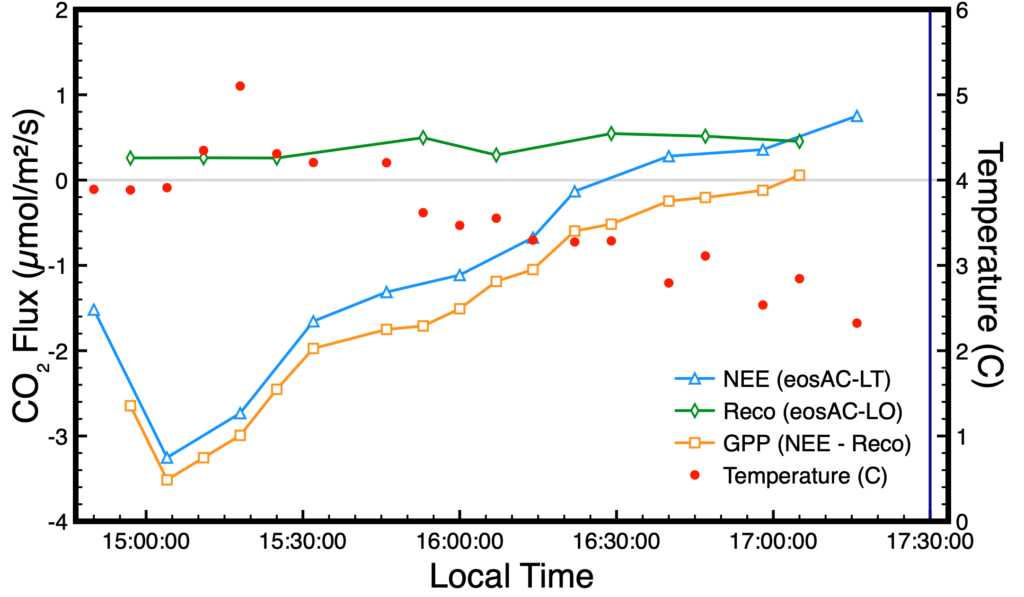INTRODUCTION
December 2020 and January 2021 were unseasonably warm in Nova Scotia, with very little snow compared to most years. Because our lawns were still bare and green early into February, we decided to do a little experiment to determine whether or not the vegetation in our front lawn was still photosynthetically active this late into the year. We measured ecosystem respiration (Reco) using the eosAC-LO opaque chamber and and net ecosystem exchange (NEE) using the eosAC-LT transparent chamber and then used those fluxes to calculate the value of gross primary production (GPP).

The front lawn of the Eosense office in Dartmouth, Nova Scotia.
DATA COLLECTION
We set up one eosAC-LT chamber and one eosAC-LO chamber in the front lawn, then connected the chambers to an ABB-LGR Ultraportable Greenhouse Gas Analyzer (UGGA) via the eosMX multiplexer. The eosMX multiplexer allows us to measure gases from both chambers using a single analyzer. The multiplexer controls the chambers via the eosLink-MX software, which runs directly on the UGGA and allows us to create custom measurement schedules. For this study we set up our chambers to collect 5 minute measurements and used the “loop” feature to collect continuous data throughout the afternoon.

The eosAC-LT (left) and eosAC-LO (right) soil gas flux chambers installed on the front lawn of the Eosense office in Dartmouth, Nova Scotia. The transparent dome of the eosAC-LT allows us to collect measurements of net ecosystem exchange (NEE) alongside measurements of soil respiration using the eosAC-LO with it’s opaque dome.
Recall that:
NEE = –NPP + Rh = –GPP + Reco
Where NPP is net primary production, Rh is heterotrophic respiration, GPP is gross primary production and Reco is ecosystem respiration. Because we did not remove the grass inside the chamber, we measured Reco instead of Rh. Therefore, Reco– NEE gives us GPP instead of NPP. If we had removed the grass from the lawn, using the same methods we’d have been able to calculate NPP instead of GPP.
DATA PROCESSING
The data was then processed using the eosAnalyze software. This software reads the log files from the eosMX and the raw gas concentration data from the UGGA to automatically generate a table of measurements. The accumulation curve for each measurement can then be viewed in the software, custom deadbands can be applied and the fluxes can be fit using both linear or exponential functions. After the data is processed, it can be exported from eosAnalyze as a .csv file for plotting and other analyses.

An example of fitting an NEE flux curve measured using the eosAC-LT chamber.

An example of fitting a Reco flux curve measured using the eosAC-LO chamber.
WHAT DID WE FIND
We found that despite being well into the winter months, the grass in our front lawn was still photosynthetically active. Low levels of ecosystem respiration were also measured, and stayed relatively constant over the measurement period despite a steady drop in temperature of ~2 °C over a period of about two hours. Overall, our front lawn was found to be a net carbon sink (i.e. NEE was negative), as uptake of CO2 by the grass (GPP) outpaced CO2 emissions from ecosystem respiration (Reco).

The NEE and soil respiration data collected from the Eosense office front lawn plotted alongside atmospheric temperature and calculated Net Primary Production (NPP).The vertical blue line indicates sunset time from Environment Canada.
Overall, our front lawn was found to be a net carbon sink (i.e. NEE was negative), as uptake of CO2 by the grass (NPP) outpaced CO2 emissions from soil respiration (Rs).
CONCLUSIONS
The eosAC-LT has a transparent dome and sidewalls, allowing us to measure net ecosystem exchange (NEE), while the eosAC-LO has an opaque dome and sidewalls, allowing us to measure soil respiration (Rs). Both chambers have internal mixing fans to ensure gases in the chamber are well mixed during the measurement period. Because the two chambers have identical volume and surface area, results between chambers can be easily compared. Using the eosAC-LT and eosAC-LO in combination allowed us to calculate net primary productivity (NPP) for our lawn.